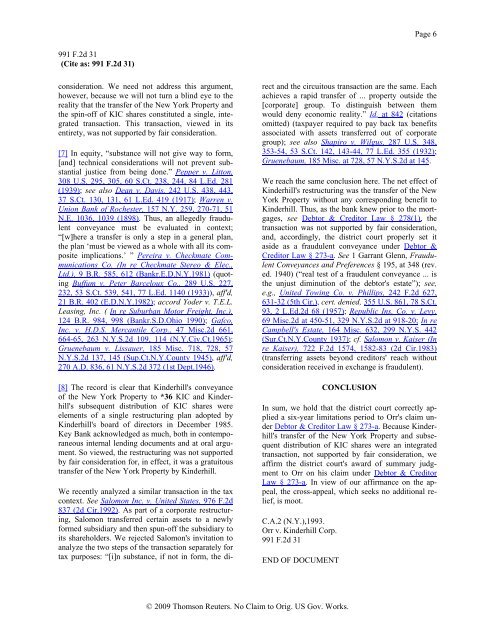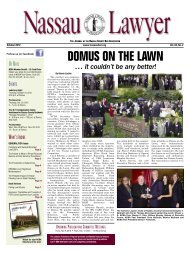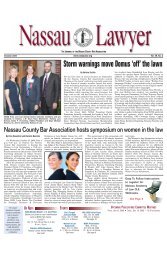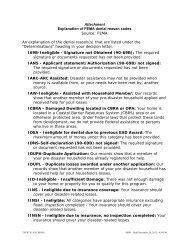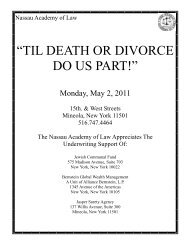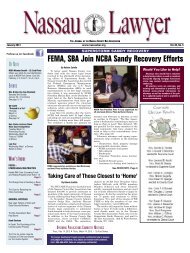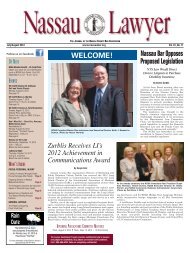FRAUDULENT CONVEYANCES Nassau Academy of Law CLE Live ...
FRAUDULENT CONVEYANCES Nassau Academy of Law CLE Live ...
FRAUDULENT CONVEYANCES Nassau Academy of Law CLE Live ...
You also want an ePaper? Increase the reach of your titles
YUMPU automatically turns print PDFs into web optimized ePapers that Google loves.
Page 6991 F.2d 31(Cite as: 991 F.2d 31)consideration. We need not address this argument,however, because we will not turn a blind eye to thereality that the transfer <strong>of</strong> the New York Property andthe spin-<strong>of</strong>f <strong>of</strong> KIC shares constituted a single, integratedtransaction. This transaction, viewed in itsentirety, was not supported by fair consideration.[7] In equity, “substance will not give way to form,[and] technical considerations will not prevent substantialjustice from being done.” Pepper v. Litton,308 U.S. 295, 305, 60 S.Ct. 238, 244, 84 L.Ed. 281(1939); see also Dean v. Davis, 242 U.S. 438, 443,37 S.Ct. 130, 131, 61 L.Ed. 419 (1917); Warren v.Union Bank <strong>of</strong> Rochester, 157 N.Y. 259, 270-71, 51N.E. 1036, 1039 (1898). Thus, an allegedly fraudulentconveyance must be evaluated in context;“[w]here a transfer is only a step in a general plan,the plan ‘must be viewed as a whole with all its compositeimplications.’ ” Pereira v. Checkmate CommunicationsCo. (In re Checkmate Stereo & Elec.,Ltd.), 9 B.R. 585, 612 (Bankr.E.D.N.Y.1981) (quotingBuffum v. Peter Barceloux Co., 289 U.S. 227,232, 53 S.Ct. 539, 541, 77 L.Ed. 1140 (1933)), aff'd,21 B.R. 402 (E.D.N.Y.1982); accord Yoder v. T.E.L.Leasing, Inc. ( In re Suburban Motor Freight, Inc.),124 B.R. 984, 998 (Bankr.S.D.Ohio 1990); Gafco,Inc. v. H.D.S. Mercantile Corp., 47 Misc.2d 661,664-65, 263 N.Y.S.2d 109, 114 (N.Y.Civ.Ct.1965);Gruenebaum v. Lissauer, 185 Misc. 718, 728, 57N.Y.S.2d 137, 145 (Sup.Ct.N.Y.County 1945), aff'd,270 A.D. 836, 61 N.Y.S.2d 372 (1st Dept.1946).[8] The record is clear that Kinderhill's conveyance<strong>of</strong> the New York Property to *36 KIC and Kinderhill'ssubsequent distribution <strong>of</strong> KIC shares wereelements <strong>of</strong> a single restructuring plan adopted byKinderhill's board <strong>of</strong> directors in December 1985.Key Bank acknowledged as much, both in contemporaneousinternal lending documents and at oral argument.So viewed, the restructuring was not supportedby fair consideration for, in effect, it was a gratuitoustransfer <strong>of</strong> the New York Property by Kinderhill.We recently analyzed a similar transaction in the taxcontext. See Salomon Inc. v. United States, 976 F.2d837 (2d Cir.1992). As part <strong>of</strong> a corporate restructuring,Salomon transferred certain assets to a newlyformed subsidiary and then spun-<strong>of</strong>f the subsidiary toits shareholders. We rejected Salomon's invitation toanalyze the two steps <strong>of</strong> the transaction separately fortax purposes: “[i]n substance, if not in form, the directand the circuitous transaction are the same. Eachachieves a rapid transfer <strong>of</strong> ... property outside the[corporate] group. To distinguish between themwould deny economic reality.” Id. at 842 (citationsomitted) (taxpayer required to pay back tax benefitsassociated with assets transferred out <strong>of</strong> corporategroup); see also Shapiro v. Wilgus, 287 U.S. 348,353-54, 53 S.Ct. 142, 143-44, 77 L.Ed. 355 (1932);Gruenebaum, 185 Misc. at 728, 57 N.Y.S.2d at 145.We reach the same conclusion here. The net effect <strong>of</strong>Kinderhill's restructuring was the transfer <strong>of</strong> the NewYork Property without any corresponding benefit toKinderhill. Thus, as the bank knew prior to the mortgages,see Debtor & Creditor <strong>Law</strong> § 278(1), thetransaction was not supported by fair consideration,and, accordingly, the district court properly set itaside as a fraudulent conveyance under Debtor &Creditor <strong>Law</strong> § 273-a. See 1 Garrant Glenn, FraudulentConveyances and Preferences § 195, at 348 (rev.ed. 1940) (“real test <strong>of</strong> a fraudulent conveyance ... isthe unjust diminution <strong>of</strong> the debtor's estate”); see,e.g., United Towing Co. v. Phillips, 242 F.2d 627,631-32 (5th Cir.), cert. denied, 355 U.S. 861, 78 S.Ct.93, 2 L.Ed.2d 68 (1957); Republic Ins. Co. v. Levy,69 Misc.2d at 450-51, 329 N.Y.S.2d at 918-20; In reCampbell's Estate, 164 Misc. 632, 299 N.Y.S. 442(Sur.Ct.N.Y.County 1937); cf. Salomon v. Kaiser (Inre Kaiser), 722 F.2d 1574, 1582-83 (2d Cir.1983)(transferring assets beyond creditors' reach withoutconsideration received in exchange is fraudulent).CONCLUSIONIn sum, we hold that the district court correctly applieda six-year limitations period to Orr's claim underDebtor & Creditor <strong>Law</strong> § 273-a. Because Kinderhill'stransfer <strong>of</strong> the New York Property and subsequentdistribution <strong>of</strong> KIC shares were an integratedtransaction, not supported by fair consideration, weaffirm the district court's award <strong>of</strong> summary judgmentto Orr on his claim under Debtor & Creditor<strong>Law</strong> § 273-a. In view <strong>of</strong> our affirmance on the appeal,the cross-appeal, which seeks no additional relief,is moot.C.A.2 (N.Y.),1993.Orr v. Kinderhill Corp.991 F.2d 31END OF DOCUMENT© 2009 Thomson Reuters. No Claim to Orig. US Gov. Works.


